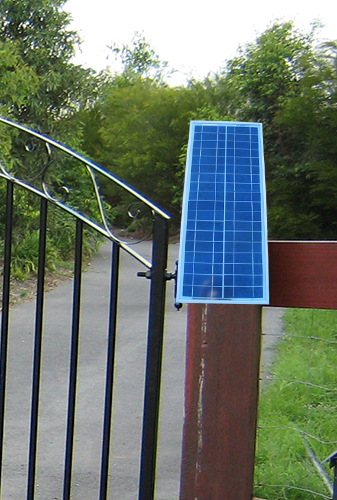When is a solar powered gate opener appropriate
As in everything, there are pros and cons to any system; the key is if the pros outweigh the cons. One of the key advantages for solar is that you do not need to run high voltage all the way out to the operator. On long runs this makes solar a viable solution. The main disadvantage with solar applications is its relatively low power capacity and the need to conserve power. If you have an operator over 100mtrs away from the nearest power line and are thinking of going solar, but absolutely need 100% operation 24 hours a day 7 days a week in a high cycle application, you would need to take into account the size of the battery pack required to have full capability during the night. Maybe running high voltage to the location would make more sense.
When installing a solar gate opener, you only get the power you can harvest from the sun and store in the battery. Just because you have a solar panel on your operator doesn’t mean you have an unlimited supply of energy. The amount of energy you get from the sun is largely determined by the size of your solar panel (usually measured in watts) and the amount of sunlight you get (usually measured in sun-hours).
What affects the amount of energy I will spend?
Many things in the gate operator system affect how much energy is required for proper operation. The single largest factor is the gate itself. Obviously, the larger the gate, the more energy it will take to move. Equally as obvious, the more often you move the gate, the more energy it will consume. Not quite as obvious is the fact that swing gates take less energy to move than comparably sized slide gates. Swing gates don’t need to move as far or operate as long and typically have less resistance in movement than slide gates; therefore they take less energy.
Generally speaking, smaller, lower duty cycle, swing gate applications are much better suited towards solar applications. However, there are always exceptions. In windy areas, slide gates often are preferred since the wind sail area of the gate doesn’t need to be pushed or pulled into the wind.
The gate opener system itself is the next main factor of how much energy will be used. The system includes the operator itself plus any accessories like loops and detectors, eye beams, access control, keypads, gate locks, and many others. Accessories like free exit devices, receivers and keypads need to be powered all the time since they need to monitor and respond to inputs at any given time.
What affects the amount of energy I can take in and store?
The amount of energy you can take in to the solar operator system is determined mainly by two things. The size of the solar panel, and the amount of sun you get. The size of the panel, usually measured in watts, is an indication of how much energy can be converted in full sun. If you have a 20 watt panel, but it’s usually cloudy, you won't usually get 20 watts. In this case you will need a larger panel to make up for this. Obviously, the amount of sun you get will depend on the panel location. Of course, don’t locate the panels in a place that might get shade either. It is also recommended to mount the panel facing full north so that you get maximum exposure all year. Another often overlooked factor in how much energy you can take in and store is the charge control circuit. Energy coming from the panel needs to be controlled so it can be stored in the battery. Most operators have either a built in charger or offer a separate charger board for this purpose.